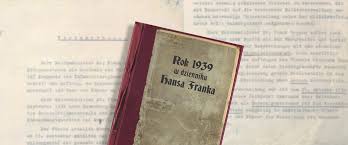“I wrote down the general account of the work done in this region since 1939 in the journals and stenographic notes of my speeches. This one of a kind documentation of work will forever remain as the testimony of the seriousness with which I took on the task given to me, as well as with how much zeal my valuable co-workers completed this task.”
Hans Frank’s statement written down in Krzeszowice, 28 VIII 1942
As cited in S. Piotrowski Sprawy polskie przed Międzynarodowym Trybunałem Wojennym w Norymberdze, Vol. I: Hans Frank’s Journal, Warsaw 1956, page 7
The General Government existed between the autumn of 1939 and spring of 1945 (until the summer of 1940 under the name General Government for the Occupied Polish Lands) and for the entirety of its existence it was led by Hans Frank. The German occupation of Poland brought countless sacrifices and suffering to Polish citizens, but Hans Frank’s vanity created a unique and priceless historical source of that time – a journal written between October 25th 1939 and April 3rd 1945 (until November 1st 1939 in Łódź, then in Cracow until January 17th 1945, and finally in Silesia and Bavaria).
The original copy of Frank’s journal counts 40 volumes (11 367 pages) and was written in the form of a one-side typescript (a transcript rewritten on a typewriter) with hand written and typed notes and corrections. Fundamentally, it consists of: 24 volumes of the diary of the General-Governor; 11 volumes of protocols and transcripts of sittings of various managing bodies and finally 5 volumes of indexes.
Following Hans Frank’s escape from the General Government to Bavaria, the journal became the property of the US army and ended up at the desk of the American General Prosecutor Investigating Axis Crimes. During the trials of the International Court Martial in Nuremberg it was used both by the defence and the prosecution. The journal then returned to Poland thanks to the initiative of Dr Stanisław Piotrowski (the Polish legal assistant of the Nuremberg prosecutors) with huge help from General Brigadier Telford Taylor (the assistant of the leading American prosecutor in the Nuremberg trials). Then, it was taken to Cracow in 1947 by the investigative judge for special matters Jan Sehn (the president of the District Commission for the Prosecution of Crimes against the Polish Nation). In order to do a photocopy, the diary was moved to Warsaw in 1952 – where, as it turned out, it stayed for good.
Reprints of parts of Hans Frank’s journal started being published soon after the war had ended. The Hans Frank’s Diary prepared for the Soviet and American prosecutors of the International Court Martial in Nuremberg by Stanisław Piotrowski was published by an unknown publisher from Leipzig (in German and Russian) already in 1945. Short fragments of the aforementioned Diary were first announced to be published in Polish by Edmund J. Osmańczyk (at the time a foreign correspondent for the Polish Radio) with the Publishing Company “Czytelnik” as well as Eugeniusz Szrojt (at the time a member of the Chief Commission for the Prosecution of Crimes against the Polish Nation) with the “Bulletin” of the Chief Commission. Parts of the journal also appeared in the official edition of the materials of the International Court Martial in Nuremberg called TRIAL or IMT.
Initiatives to publish an academic version of the entire journal began already in the second half of the 1940s. The first attempts were made by the Chief Commission for the Prosecution of Crimes against the Polish Nation (in Warsaw) and the Western Institute in Poznań, but they were quickly abandoned due to financial reasons as well as because of censorship (due to USSR’s role in the war). Later, more fragments of the diary were published. Already mentioned Jan Sehn (since 1949 a director of the Institute of Forensic Research in Cracow) proposed an edition picturing the “main policies of the occupants and Nazi crimes as well as the issues of security in the General Government, development of the resistance and the way it was fought with”. The idea was not accepted, but it was the starting point for the further works of the Warsaw headquarters of the Chief Commission for the Prosecution of Nazi Crimes and was finally materialised in the form of a two-volume edition of the Book and Knowledge.
In 1953, a new concept appeared – in accordance with the historical policies in Poland at that time – to provide readers with a “document coming from an authentic Nazi source confirming in its entirety the thesis prevalent during all the trials of traitors and collaborators from the time of the occupation, that the only true, patriotic resistance acting for the best interests of the Polish nation was the leftist resistance”. The full Polish translation of the aforementioned Diary was published in 1956 by Stanisław Piotrowski and the Legal Publisher. In 1970, the Book and Knowledge publisher delivered the only Polish edition of parts of the journal which was critical. Five years later, Werner Präg and Wolfgang Jacobmeyer published at the Deutsche Verlags-Anstalt a wide German critical selection of the diary. To commemorate the 40th anniversary of the outbreak of the Second World War the Leske Verlag and Budrich GmbH delivered another, much slimmer selection prepared by Imanuel Geiss and again Wolfgang Jacobmeyer.
In the edition currently under creation, a uniform, chronological concept of publishing the source was adopted, so the diary and protocols, despite their formally separate transcripts, weren’t divided into two different parts. Especially for this edition, all the documents from the original German copy are being gradually translated. The entire edition will amount to seven volumes (the longest ones will probably be divided into several parts).
PAWEŁ KOSIŃSKI
